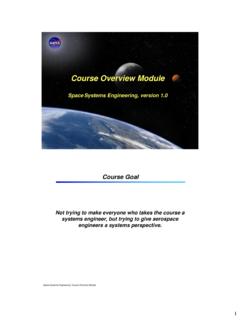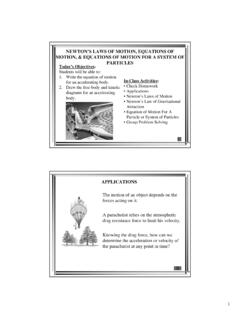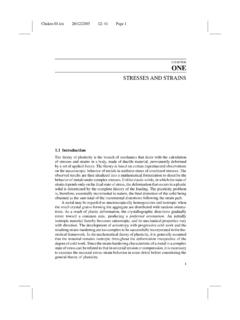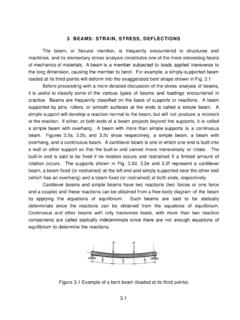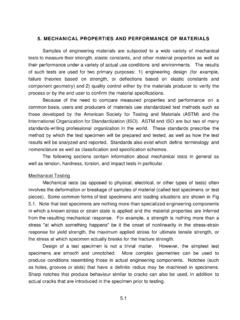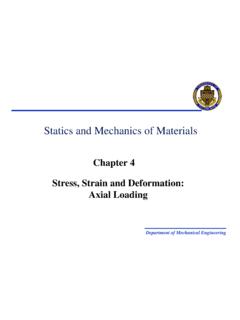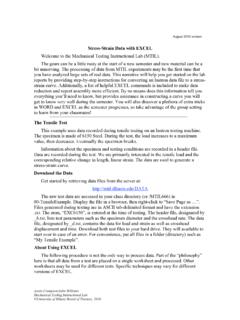Transcription of Mechanics Concrete Stress-Strain
1 MechanicsMechanicsConcrete StressConcrete stress --StrainStrain We must test a batch of Concrete to determine its properties. The material properties of Concrete are not constant as they are for a material like steel. They depend upon many factors including: the amount of cement; gravel; sand; and especially the amount of water added to the mix. Conc Strs-Strn2 Concrete Cylinder TestsConcrete Cylinder Tests Compression testson the Concrete cylinders are run to obtain: The ultimate strengthof the Concrete ,f C The Stress-Strain curve to obtain the Modulus of Elasticity of Concrete , ECIt is tested by applying a compressive load until failure, and measuring the stress and strain . The maximum stress that the cylinder can take prior to failure is the ultimate strength. The slope of the Stress-Strain diagram is the Modulus of Elasticity. Since Concrete properties vary so much from one batch to another, actual lab tests need to be run to truly determine the material properties.
2 The cylinder compression test is the most commonly run test. In this test, the Concrete cylinder is 12 inches long and 6 inches in diameter. Conc Strs-Strn3 Concrete StressConcrete stress The datacollected included the applied load and the resulting change in lengthof the cylinder between the attached rings To get the stress ,we divide the load by the area46P4 DPAP22C = == Here is the equation for stress for a 6 inch diameter cylinder. Conc Strs-Strn4 Concrete StrainConcrete strain The datacollected included the applied loadand the resulting change in lengthof the cylinder between the attached rings. To get the strainwe divide the change in length by the original length62 LLC = = The displacement value, , has been doubledby the measurement apparatus The distance between the rings was 6 The particular strain measuring device we used in this test magnifies the displacement by a factor of two.
3 This increases the reading and makes it somewhat more accurate. The rings that attached to the cylinders for measuring the displacement were 6 inches apart. Conc Strs-Strn5 Concrete StrengthConcrete Strength Here is a plot of the resulting stress vs. strainStress(psi)strainf c The maximum stress that the Concrete can take, the Concrete strength,is called f CYou may have to correct your data around the zero point. Graph starts at zero stress and zero The strength is simply the maximum load divided by the area. Note that after the maximum load is reached, the strain continues to increase as the stress decreases. The f C is not the stress at the end of the test, it is the maximum stress applied to the cylinder, at the top of the curve. To get this plot you will have to correct the deflection data. There might be a lot of phony readings at the beginning. Discard all data that was recorded before the load started to increase.
4 You also need to get rid of the data at the end of the test. You just want the data that defines the curve similar to the one shown. Also start the test with zero displacement by subtracting out the reading at the start of the test. Conc Strs-Strn6 StressStress-- strain CurveStrain Curve Here is a plot of the resulting stress vs. strainStress(psi)strainf c When you test several cylinders, you average the values of f CYou will have a Stress-Strain diagram like this for each cylinder Again, f C is just the maximum load divided by the area. You will have a value for the ultimate strength even if you do not measure the strain . Conc Strs-Strn7 StressStress-- strain CurveStrain Curve Here is a plot of the resulting stress vs. strainStress(psi)strainf c You will have many data not use symbols,and smooth the curveso it looks good and is meaningful. You can check this trendline by plotting the data with symbols and viewing the trendline, drawn with a light colored line, on top of the symbols.
5 When satisfied with the line, delete the symbols and color the line appropriately. Plot the data without symbols. If symbols are used, they will be so close together that they will merge together and look like a very wide line. Put a high order trendline through the data so that it matches the data well. Conc Strs-Strn8 Nonlinear DiagramNonlinear Diagram Note that the curve is a nonlinearoneStress(psi)strainf c Since E is the slopeof the diagram, we see that E changes with stress level As you can see, Concrete is a nonlinear material. As the stress level increases, the slope of the curve decreases, meaning that EC, the modulus of elasticity of the Concrete , decreases. The Stiffness of the Concrete decreases at higher stress levels. Conc Strs-Strn9 Modulus of ElasticityModulus of Elasticity What should we use for EC, the modulus? stress (psi)strainf c During normal use, in what stress region is the Concrete operating?
6 Somewhere in this region Since we always design structures with a factor of safety, generally the stresses during normal operation of a Concrete structure will be in the region indicated on the diagram. We try to avoid stresses that approach the failure level. Conc Strs-Strn10 For the first halfof the test, the Stress-Strain curve is pretty straightStress(psi)strainf c2fc'EcEECC--Modulus of ElasticityModulus of Elasticity The slope of this lineis taken to be EC In this region, the slope of the Stress-Strain curve is fairly constant. Conc Strs-Strn11 For the first halfof the test, the Stress-Strain curve is pretty straightStress(psi)strainf c2fc'EcEECC--Modulus of ElasticityModulus of Elasticity Do a regression(trendline) through these data points(below f C/2). The slope is called EC To get the slope of this line, we choose the data points up to about one half the ultimate strength and perform a linear regression to get the best straight line through the data.
7 The slope of this regression line (trendline) is the value of EC. Conc Strs-Strn12 Approximate Modulus of ElasticityApproximate Modulus of Elasticity Based upon examining a series of Concrete cylinder tests, an equation for estimating the Modulus of Elasticity of Concrete was derived This is simply an easy equation to useCApprox'f57000E= f Cin this equation must be in psi Comparethe value from this equation to your measured values It is frequently not very accurate This equation is an empirical equation. It resulted from examining numerous Stress-Strain curves and finding an easy formula that would approximate EC. Being an easy equation was more important than being extremely accurate. Conc Strs-Strn13 Modular RatioModular Ratio We tested at least two cylinders for stress and strain . Take ECto be the average of the slopesof the two lines Once we have EC, we can determine the modular ratio, nCCsEksi29000 EEn== Make sure that the units are in agreement.
8 With this modular ratio it is now possible to examine the reinforced Concrete beam to create the transformed section.


